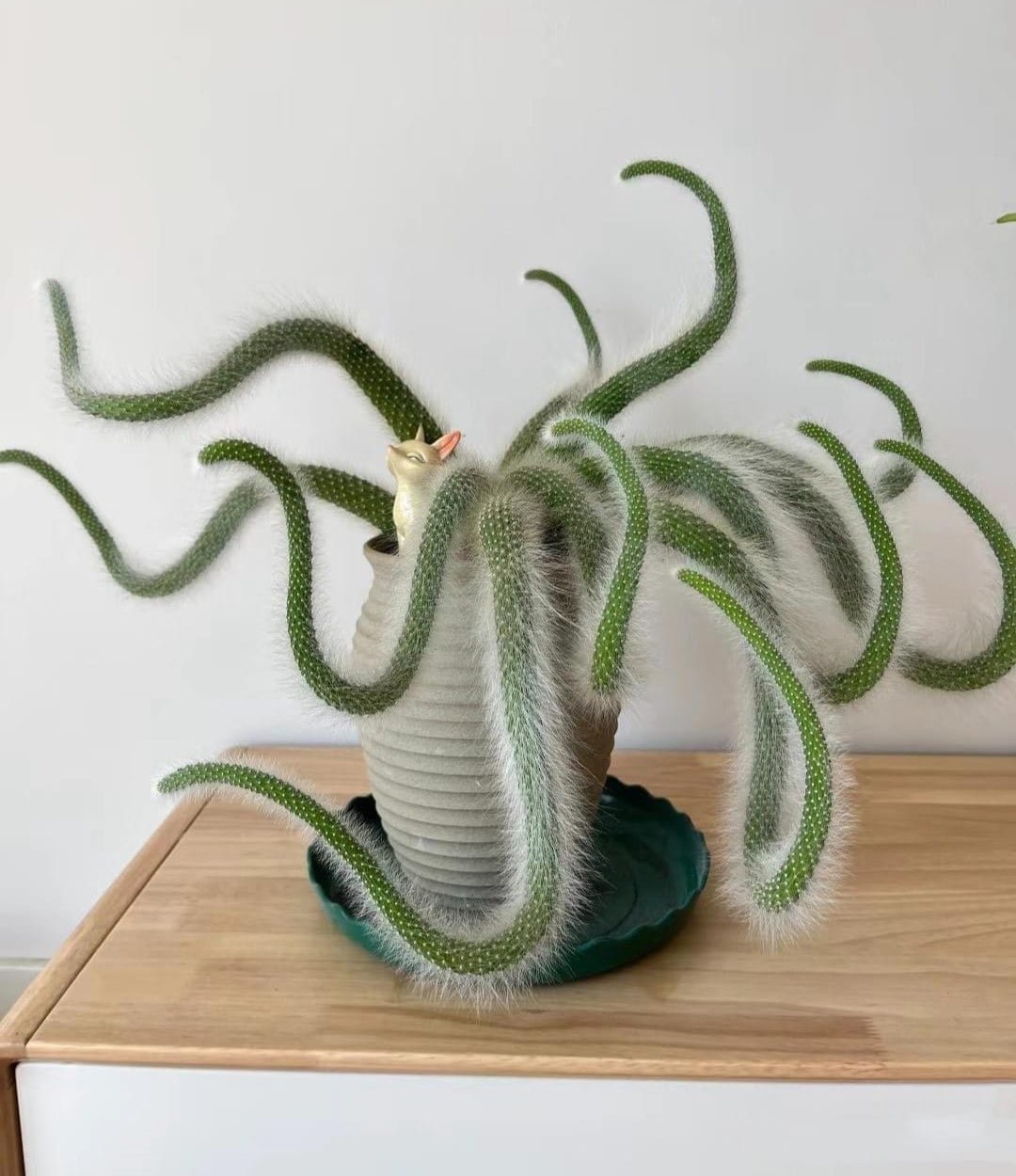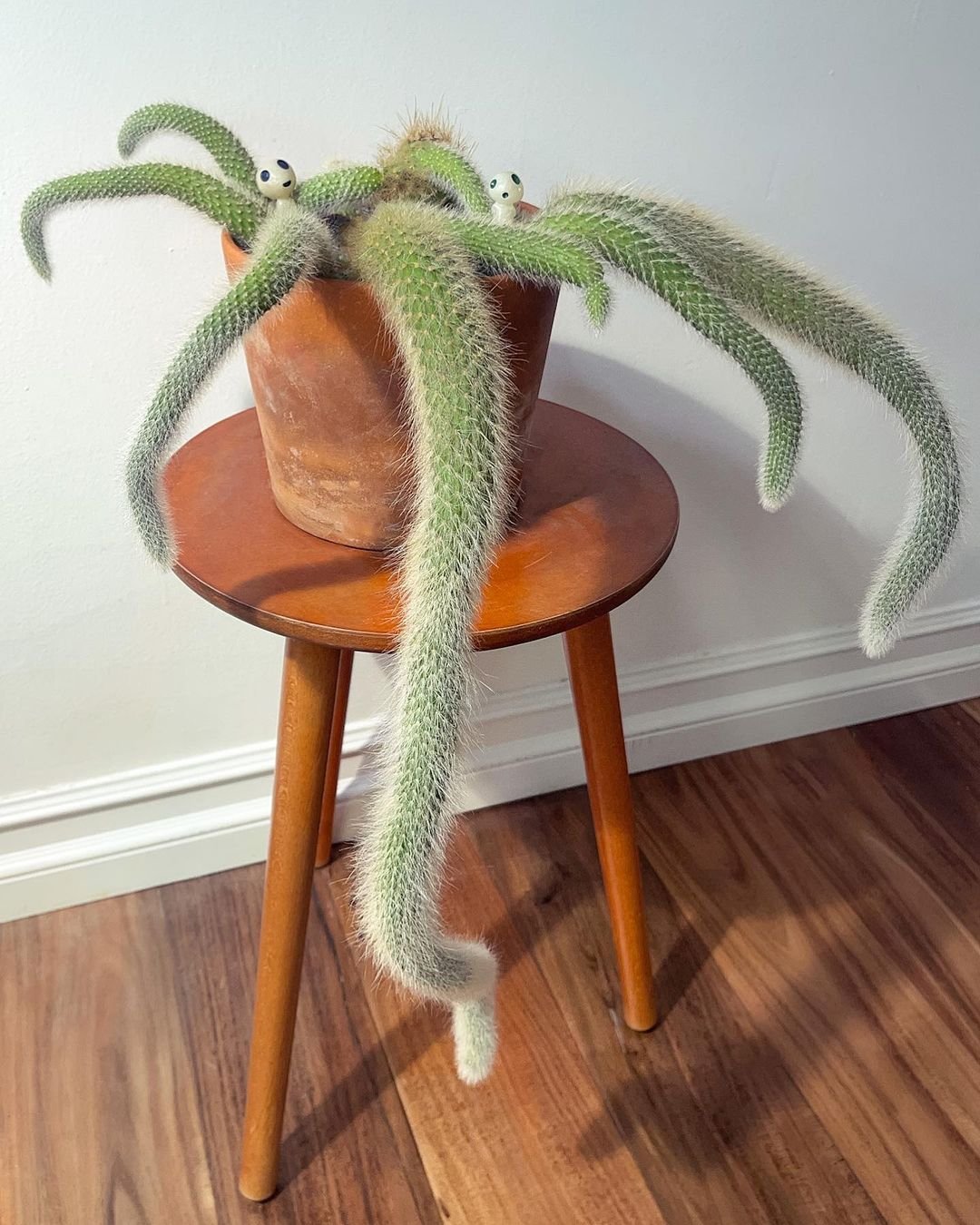The whimsical Monkey Tail Cactus makes a unique, low-maintenance indoor plant. Learn how to care for this trailing succulent and get tips on varieties and growing needs.
Are you looking for an interesting, low-maintenance plant to add some quirky flair to your home or office? The monkey tail cactus could be just the thing! With its long, trailing stems covered in fuzzy white hairs, this delightful plant resembles – you guessed it – the tail of a monkey swinging from a tree branch.
Beyond its novelty appeal and whimsical appearance, the monkey tail succulent is also incredibly easy to grow indoors or out. Like most cacti, it’s tough and forgiving of a bit of neglect, requiring little more than the basics to thrive.

From bright sunny windowsills to shaded patios or fairy gardens, the monkey tail’s trailing stems can spill over containers to put on a fun, furry show. Let’s take a closer look at how to make this unique plant feel right at home in your space.
The Monkey Tail Cactus, also known as Cleistocactus winteri, is a unique and visually striking cactus species. Here’s a concise information chart about it:
| Attribute | Information |
|---|---|
| Botanical Name | Cleistocactus winteri |
| Plant Type | Cactus |
| Zones | 9-11 (typically grown as a houseplant) |
| Exposure | Bright, indirect sunlight |
| Bloom Time | Spring to early summer |
| Height/Spread | Height: Up to 6 feet Spread: 1-2 feet |
What is the Monkey Tail Cactus?

The monkey tail cactus (Bahuinia brachycalyx) isn’t a true cactus at all, despite its resemblance to a hairy saguaro arm. It’s actually a small perennial succulent native to the deserts of west-central Mexico.
As it matures, this plant develops long, rope-like stems densely covered in soft white hairs or trichomes. These fuzzy appendages earned it the common name “monkey tail” along with other amusing monikers like fox tail cactus, bunny tail cactus or polka dot cactus.
In nature, these trailing stems can reach up to 3 feet long and tumble over the edges of rocky canyon walls or dangle from tree branches. When grown in containers, the shaggy stems typically max out around 2 feet or so in length.
Monkey tails stay quite small and compact when young, making charming little houseplants. Some cultivars also boast decorative reddish-brown or golden tones on the stems in addition to the white fuzz.
Despite their delicate and fuzzy appearance though, these are actually quite hardy and drought-tolerant plants well-suited for growing indoors or in warm, sunny outdoor conditions.
Benefits of Growing Monkey Tails

Aside from their irresistibly fun and whimsical looks, monkey tail cacti offer home gardeners a bunch of advantages over fussier houseplants, including:
- Extremely drought-tolerant and unfussy once established
- Safe and non-toxic around children and pets
- Thrive on infrequent watering and low humidity
- Tolerate low light conditions indoors
- Perfect for those with “black thumbs”
- Minimal maintenance and few pest issues
- Unique hanging basket or container accents
- Trailing stems soften hardscapes like walls or shelves
The effortless care requirements and pet-friendly nature of these novelty succulents make them perfect for newbie gardeners, apartment dwellers or anyone looking for a fun, low-maintenance addition to their indoor plant collection.
If you really want to make your monkey tails happy, give them a sunny spot and pretty decent drainage, and they’ll quickly become one of the easiest and coolest plants you’ll ever own!
Growing and Caring for Monkey Tail Cactus
Getting started with monkey tail plants is simple if you follow a few basic guidelines for potting mix, light, watering and more.
Planting Tips

Monkey tails grow best in a well-draining cactus or succulent potting medium. A 50/50 mix of quality potting soil and coarse sand or perlite works nicely. Or look for commercial mixes specifically designed for cacti and succulents.
Be sure to select a container with plenty of drainage holes to prevent soggy soil and root rot issues. Terracotta clay and wooden planters are great breathable options.
Gently untangle the roots and plant your monkey tail at the same level it was growing in its previous nursery pot. Backfill around the base with your potting mix, firming it down gently to stabilize the plant.
Light Requirements

In the wild, monkey tails grow in full sun exposure and need plenty of bright light to maintain their best color and form indoors as houseplants. An unobstructed south or west-facing window makes an ideal spot.
If growing outdoors in warm climates, aim to provide 6+ hours of direct sunlight per day or use afternoon shade in desert areas with intense sun. Too much shade can cause the stems to stretch out and lose their compact shape.
Proper Watering

Like most desert-dwelling succulents, monkey tails are quite drought-resistant and prefer infrequent, deep watering to light, frequent doses. This allows the soil to dry out completely between waterings.
In the spring and summer growing season, check your plant weekly and water thoroughly once the potting mix is fully dry and the container feels light.
Pour water over the soil surface until it begins running out of the drainage holes, then let it drain completely. Discard any excess water from the saucer or cachepot.
During the winter months when growth naturally slows or stops, cut back watering significantly. A light misting every few weeks is usually sufficient in a warm, sunny spot.
Signs you’re overwatering include soft, wrinkled or discolored stems, mushy spots, or white mold on the soil surface. If the
stays overly damp for prolonged periods, the plant will rot.
Fertilizing Needs

Fertilizing isn’t required for monkey tails, but an occasional application of a balanced, diluted fertilizer can help fuel fuller, denser stem growth.
During the active growing season, you can give them a light dose of liquid succulent fertilizer or top-dress with a balanced controlled-release fertilizer every few months.
Alternatively, some gardeners find monkey tails thrive on compost tea or worm castings rather than chemical fertilizers. Just be sure not to overfeed.
Temperature and Humidity Needs

Optimal temperatures for monkey tails range from 65-90°F during the day and no lower than 50°F at night. Overall, they perform best in average to warm indoor conditions with good airflow.
These plants can handle lower humidity quite well, though their stems may develop some wrinkling if it’s extremely dry in winter. Light misting or a pebble tray can add humidity if needed.
Hardy only down to about 30°F, be sure to protect outdoor plants from cold snaps or bring them inside when the mercury dips below freezing.
Pruning and Propagating

Pruning isn’t required for monkey tails except to remove any damaged or dead stems as needed. You can also trim back any wayward growth to maintain a tidy, trailing shape in your container.
Use clean, sterile pruners or scissors to snip off stems, leaving 4-6 inches of length intact on the plant. The cuttings can then be allowed to callous over for a few days before rooting in fresh potting mix.
Or you can create new plants by simply picking off the plantlets that form on the stems and rooting them in their own containers. The propagated cuttings should develop roots within several weeks or months with very little effort.
Potential Problems

When given proper care and conditions, monkey tails are generally pest and disease-free plants. However, a few common issues to watch for include:
- Root rot from wet, soggy soils
- Pest infestations like mealybugs or scale
- Shriveled or mushy stems from under/overwatering
- Leggy growth from insufficient light
- Cold damage on outdoor plants below freezing
Providing excellent drainage, letting the soil dry between waterings, and giving them bright light will eliminate most problems. Pests can typically be removed by hand or spot-treated with neem oil or insecticidal soap if severe.
Popular Monkey Tail Varieties

While the standard golden or rusty reddish-brown species is the most common, there are also a few unique cultivars to check out:
B. brachycalyz ‘Hirschii’ – Gray-blue “frosted” stems covered in dense, silvery hair
‘Mounted Yellow Tones’ – Bright golden yellow stems aging to deeper gold
‘Ruby Ruby’ – Densely furred stems tinged with hints of red and brown
Hirsuta Noid – Exceptional long trailing stems to over 4 feet
Hybrid cultivars are constantly being introduced too, so check your local garden center each season for any fun new options!
From their manageable size to their charming fuzzy appendages, monkey tail cacti make wonderful and unique indoor plants or fun additions to fairy gardens and covere
Pingback: Monkey Tail Cactus: A Fun, Easy-Care Succulent ...
Pingback: The Ultimate Guide to Cleistocactus Icosagonus
Pingback: - Aloe Plants: Comprehensive Guide to Growing Aloes